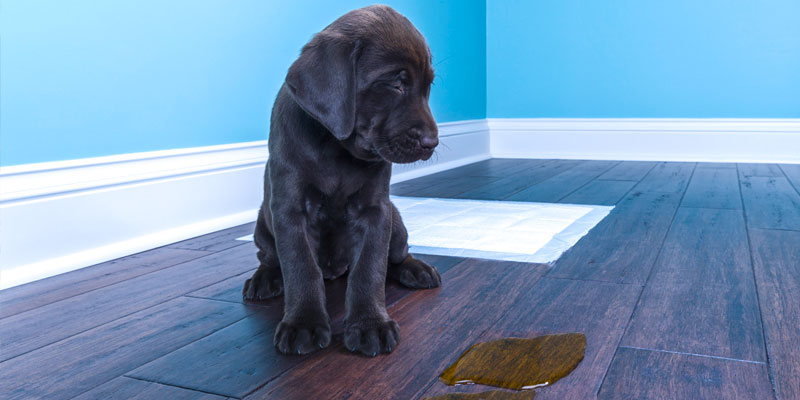Picture this: you’re walking through your home, enjoying the warmth of the hardwood floors beneath your feet. Suddenly, a pungent odor hits your nose, and you realize your furry friend has left their mark. Pet urine stains and odors can turn your once beautiful floors into a source of frustration. But don’t despair! There’s a solution for every paw print.

Image: floorvee.com
Hardwood floors, while elegant and durable, can be particularly susceptible to the damage that pet urine can cause. It can seep deep into the wood, leaving behind discoloration, a persistent odor, and even structural damage if left untreated. This guide will equip you with the knowledge and tools to effectively remove pet urine from hardwood floors, restoring them to their former glory.
Understanding the Problem: The Science Behind Pet Urine
Pet urine consists of a powerful cocktail of chemicals, including uric acid, ammonia, and other organic compounds. These components can quickly penetrate wood, staining the surface and emitting a strong, unpleasant smell. The longer the urine sits, the deeper it seeps, making it harder to remove. Simply wiping away the surface stain won’t be enough. You need a solution that tackles both the visible stain and the underlying odor.
Step-by-Step Guide to Removing Pet Urine Stains: A Journey Back to Fresh Floors
Here’s a step-by-step guide to remove pet urine stains from your hardwood floors, keeping in mind that each situation may require a slightly different approach.
Step 1: Immediate Action:
The moment you discover a urine accident, time is of the essence!
- Blot, Don’t Rub: Quickly soak up as much of the urine as possible using absorbent paper towels or a clean cloth. Avoid rubbing, as this can spread the urine further into the wood.
- Flush the Spot: Once most of the urine is absorbed, flush the area with clean water. This can help dilute the urine and flush out some of the chemicals.
Step 2: The Power of Enzyme Cleaners:
Enzyme cleaners are your secret weapon for tackling pet urine.
- How They Work: Enzyme cleaners contain biological enzymes specifically designed to break down the organic compounds in pet urine, effectively eliminating the source of the odor.
- Application: Apply a good-quality enzyme cleaner following the manufacturer’s instructions. Some products may require a dwell time, allowing the enzymes to work their magic. Let the cleaner sit for the recommended period before blotting it up with a clean cloth.
Step 3: The Deodorizing Duo: Vinegar and Baking Soda
Often, an enzyme cleaner alone isn’t enough to tackle stubborn odors. A combination of vinegar and baking soda can work wonders.
- Vinegar’s Power: Vinegar is acidic and can help neutralize the ammonia in pet urine.
- Baking Soda’s Strength: Baking Soda acts as an absorbent, soaking up remaining moisture and odors.
- The Formula: Mix equal parts white vinegar and water in a spray bottle. Saturate the affected area with the solution, and let it sit for a few minutes. Then, sprinkle baking soda over the damp area. Let it work its magic for about 30 minutes before vacuuming it up.
Step 4: The Art of Stain Removal:
While enzyme cleaners are excellent for eliminating odor, they may not always fully remove visible stains.
- Commercial Stain Removers: Consider using a commercial stain remover specifically formulated for hardwood floors. Follow the instructions carefully and test the cleaner in an inconspicuous area first.
- Natural Alternatives: For a more natural approach, you can try using a paste made from baking soda and water. Spread the paste over the stain and let it sit for a few hours before gently scraping it off with a plastic spatula.
Step 5: The Final Touches:
After addressing the urine, there are a few steps you can take to restore your floors to their former brilliance.
- Thorough Cleaning: After the stain removal process, thoroughly clean the entire floor to remove any residue.
- Polishing and Refinishing: If the stain has significantly discolored the wood, you may need to sand and refinish the affected area.
Expert Insights and Actionable Tips for Long-Term Success
Expert Tip 1: Prevention is Key: The best way to deal with pet urine accidents is to prevent them in the first place.
- Potty Training: Consistent potty training can minimize the risk of accidents.
- Regular Cleaning: Frequent cleaning can help remove any traces of urine before they become noticeable.
- Pet-Friendly Products: Use pet-friendly cleaning products that effectively remove pet odor without harming your hardwood floors.
Expert Tip 2: Professional Help: If you’re struggling to remove pet urine stains, don’t hesitate to call in a professional.
- Trained Experts: Professional cleaning services have specialized tools and expertise to tackle even the most stubborn stains.
- Prevent Further Damage: Ignoring deep-set stains can lead to lasting damage, so seeking professional help can save your floors in the long run.

Image: floorvee.com
How To Get Pet Urine Out Of Hardwood Floors
Conclusion: Restoring Your Hardwood Floors to Their Former Glory
Removing pet urine from hardwood floors can seem daunting, but it doesn’t have to be an overwhelming task. By following these steps and utilizing the right products, you can reclaim the beauty of your floors while tackling the unpleasant odors. Remember, proper prevention, timely action, and a little elbow grease can often make all the difference.
Don’t hesitate to share your experiences and tips with others. Together, we can create a space where pets and beautiful hardwood floors can coexist harmoniously.





